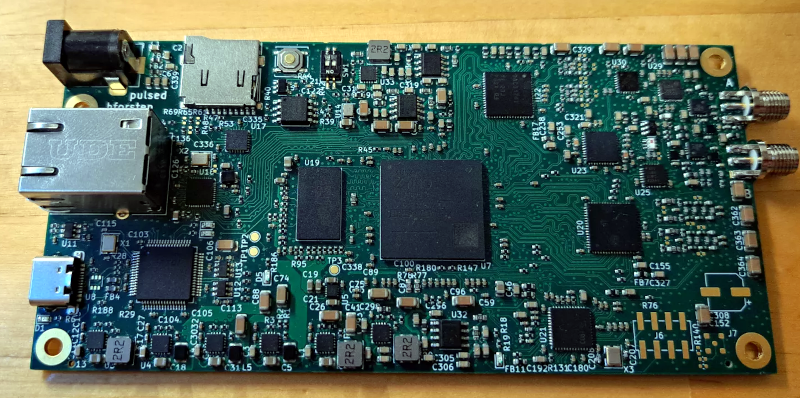Conceptually, radar is pretty simple: send out a radio wave and time how long it takes to get back via an echo. However, in practice, there are a number of trade-offs to consider. For example, producing a long pulse has more energy and range, but limits how close you can see and also the system’s ability to resolve objects that are close to each other. Pulse compression uses a long transmission that varies in frequency. Reflected waves can be reconstituted to act more like a short pulse since there is information about the exact timing of the reflected energy. [Henrik] didn’t want to make things too easy, so he decided to build a pulse compression radar that operates at 6 GHz.
In all fairness, [Henrik] is no neophyte when it comes to radar. He’s made several more traditional devices using a continuous wave architecture. However, this type of radar is only found in a few restricted applications due to its inherent limitations. The new system can operate in a continuous wave mode, but can also code pulses using arbitrary waveforms.
Some design choices were made to save money. For example, the transmitter and receiver have limited filtering. In addition, the receiver isn’t a superheterodyne but more of a direct conversion receiver. The signal processing is made much easier by using a Zynq FPGA with a dual-core ARM CPU onboard. These were expensive from normal sources but could be had from online Chinese vendors for about $17. The system could boot Linux, although that’s future work, according to [Henrik].
At 6 GHz, everything is harder. Routing the PCB for DDR3 RAM is also tricky, but you can read how it was done in the original post. To say we were impressed with the work would be an understatement. We bet you will be too.
Radar has come a long way since World War II and is in more places than you might guess. We hate to admit it, but we’d be more likely to buy a ready-made radar module if we needed it.
















That’s pretty amazing stuff considering during WW2 we used microwave ovens to both construct radars for detecting enemy planes and as decoys for jamming their HARM missiles.
Even more exciting was this project which used COTS RTL-SDRs as passive radar but I can’t find it anymore.
As memory serves the project was a little too successful and was taken down due to ITAR violations (what a world we live in)
Are you thinking of the kracken SDR?
We did not use microwave ovens to construct radars… the magnetron was invented to improve existing radar, and the patent for using it to heat food wasn’t filed until 1945. Radar and magnetrons predate microwave ovens.
“However, this type of radar is only found in a few restricted applications due to its inherent limitations.”
Did you mean that pulse compression (sometimes called CHIRP) isn’t common?
For about the last 10 years it’s been fairly common in recreational maritime radars (like the Simrad HALO et al). These can be had for about 2 kilodollars.
No, I can see how you misread it though — it isn’t as clear as I wanted it to be:
>In all fairness, [Henrik] is no neophyte when it comes to radar. He’s made several more traditional devices using a continuous wave architecture. However, this type of radar is only found in a few restricted applications due to its inherent limitations.
I mean the CW radars are not common except a few special cases like car radar etc.
“The signal processing is made much easier by using a Zynq FPGA with a dual-core ARM CPU onboard. These were expensive from normal sources but could be had from online Chinese vendors for about $17.00.”
Oh yeah? How does that work? There’s supposed to be an ITAR embargoe in-place to keep U.S. high-tech out of China’s missile-building grubby hands. So now China is selling AMD/XILINX Zynq FPGAs with dual-core ARM IP to the USA for about $17.00 bucks a-pop? How did that happen? Are the chips fake? At Mouser I randomly picked an XC7Z010-2CLG400I dual core 776 MHz ARM Cortex A9, qty.-222 in stock, qty.-1 to 1,000 $107.58 ea., NOT $17.00.[1][2]
1. XC7Z010-2CLG400I @ Mouser In-Stock: 222 $107.58 ea.
https://www.mouser.com/ProductDetail/AMD-Xilinx/XC7Z007S-1CLG225C?qs=rrS6PyfT74fgOhuz6L0Z5g%3D%3D
2. XC7Z010-2CLG400I @ Digi-Key In-Stock: 128 $107.59 ea.
https://www.digikey.com/en/products/detail/amd/XC7Z010-2CLG400I/3925757?s=N4IgTCBcDaIBoGEDsAtADARjQWjAgMgOIAsaaAkiALoC%2BQA
UPDATE: At LCSC.com (China) I did find the AMD/XILINX XC7Z010-2CLG400I for sale, In Stock: 528, qty.-any $19.54 USD ea. Wow! LCSC lists this part as, “Single Chip Microcomputer/Microcontroller/Microcontroller Units (MCUs/MPUs/SOCs)”, NOT an FPGA.[1] So maybe this tale of cheap-Chinese AMD/XILINX FPGAs is credible after all!?
1. XC7Z010-2CLG400I @ LCSC In-Stock: 528 $19.54 ea.
https://www.lcsc.com/product-detail/Microcontroller-Units-MCUs-MPUs-SOCs_AMD-XILINX-XC7Z010-2CLG400I_C2840993.html
if you read the writeup, he notes some fishiness with the FPGAs being possibly remarked…as for why though, nobody knows…
AKA the A said: “if you read the writeup, he notes some fishiness with the FPGAs being possibly remarked…as for why though, nobody knows…”
I did go back and read the writeup and picked this up:
“The suspiciously cheap $15 FPGA had equally suspiciously date and lot codes covered (white rectangles on the FPGA chip in the picture above). I have a development board of the same series chip with markings intact, so it definitely shouldn’t look like this. It did end up working, but I wonder what the origin of these chips is.”
So the OP [Henrik Forstén] suspects the cheap Chinese FPGAs are fake; but then he goes on to add: “It did end up working…”, which I find very peculiar. I cannot believe AMD\XILINX would build something as sophisticated as their “Vivado Design Suite” (even the crippled WebPACK version) without strong support for verifying the hardware connected to it is genuine.[1] Then there’s still the open question of: “Does the AMD\XILINX FPGAs being sold in China run afoul of the U.S. International Traffic in Arms Regulations (ITAR) resrictions?”
1. Vivado
https://en.wikipedia.org/wiki/Vivado